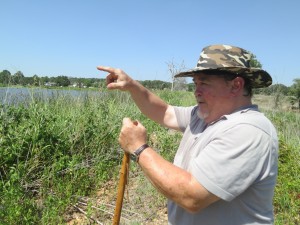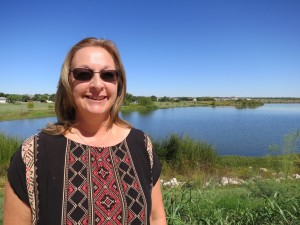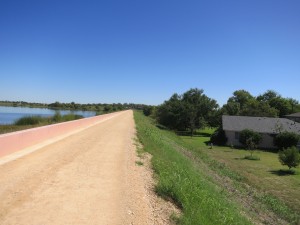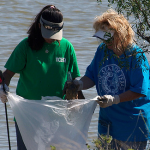Aging Dams, Booming Growth, and the Search for Solutions

Photo by Mose Buchele
Bruce Bar is a certified floodplain manger and caretaker of his neighborhood dam in Bastrop County.
This is part four of a series looking at the infrastructure of dams in Texas, and what can be done to improve it. You can find part one here, and part two here, and part three here.
In a peaceful, wooded corner of Bastrop County, Texas sits one of the unluckiest dams in the state. In 2011 the Labor Day Wildfires burned soil and vegetation around Clear Springs Lake and its earthen dam. Then, half a year later, a massive rainstorm hit. Water poured over the structure and wrecked havoc on an already crumbling spillway.
“Our poor little dam has gone between being scorched to being flooded in a matter of six months,” Bruce Bar, a floodplain engineer and the manager of the community’s dam told StateImpact Texas. “So it’s handled about as much as nature can throw at it.”
In his role as manager of the dam, Bar has been looking to raise money for repairs.
“We had a homeowners association meeting and some people got rankled because they didn’t even know that we had a dam, and they had been here for ten or twelve years or so,” he said. “If all of a sudden if they start getting a bill saying they’re due so many thousands of dollars. I think that’s… that could be a problem.”
Aging and lack of maintenance are effecting both private and public dams in the state, but so is an absence of money says Warren Samuelson, the Manager of the Dam Safety Program for the TCEQ.
“What we need is what some other states have done, they’ve designated a pot of money where owners can come in that have issues with their dam and try to get some funds based upon whatever criteria is set up,” Samuelson said.
In some states that money comes from dam permits and inspection fees. Samuelson said another solution would be to introduce fees paid by developers when a subdivision goes in downstream from a dam, increasing its hazard level.
There is some precedent for charging development for its impact on waterways. Developers sometimes pool their money to ensure the quality of water flowing downstream from developments, said Ruth Haberman, the General Manager of the Upper Brushy Creek Water Control and Improvement District.
“So the same kind of thing could be done with dams, if everybody looks upstream at how their development is impacting upstream and contributing to whatever modernization or protection is done upstream then we could do the same type of thing,” Haberman said.
That could be a hard sell. Mark McPherson is a lawyer who represents developers and property owners at the TCEQ. He said he’s not averse to the idea of a fund, but he doesn’t think it should be reliant on new development fees.
“Is it fair that somebody gets a piece of property that’s improved with a dam and with the water that’s behind the dam and the states paying to maintain the dam?” McPherson asked, “How fair is that?”
Even if a fund was created to maintain dams, it would not address the second major challenge: irresponsible growth around dams.

Photo by Mose Buchele
Ruth Haberman is a floodplain manager in the booming suburbs outside of Austin.
“There’s no mechanism to keep to keep development from building up downstream of dams at this point. There are a lot of people scrambling to do that,” said Haberman. “I have no regulating authority. TCEQ is the same; they can tell what the issues are but they don’t really have any regulatory authority downstream.”
“If they don’t make wise choices, and build where maybe they shouldn’t. Then we all have to deal with the consequences,” Haberman added.

